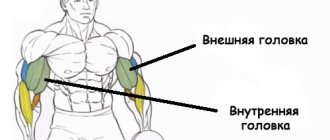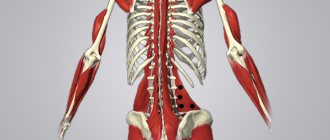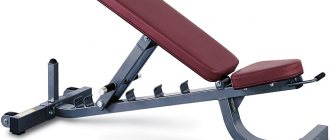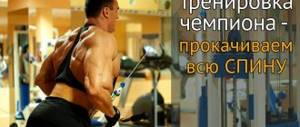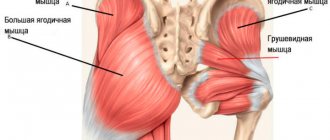To understand how to properly pump your back, it is useful to know that there are deep and superficial back muscles. The first layer is formed by the latissimus and trapezius muscles, the rhomboid and serratus muscles lie deeper.
It is better not to combine back exercises in the gym with working out other large muscle groups, such as the pectoral muscles. Can be combined with exercises for the shoulder girdle (deltas), abs. Isolated back exercises should always be performed after basic exercises.
Vince McMahon training
Wrestling promoter and head of the WWE, Vince McMahon is proud of his powerful back. Follow his instructions to build your own giant with three giant sets.
Vince McMahon trains up to seven days a week, sometimes training twice a day if he knows he might miss a session due to his grueling schedule. Vince's split looks like this: chest, shoulders, arms, legs and back (this is his strongest body part and his favorite workout).
McMahon performs most exercises as giant sets, doing them in groups of three.
Giant set 1
1A. Wide Grip Lat Pulldowns – 3 sets of 15, 12, 10 reps (Do one set, then move on to exercise 1B. Rest 30 seconds after doing exercise 1C)
1B. Bent Over Rows - 3 sets of 15, 12, 10 reps (Do one set, then move on to exercise 1C. Rest 30 seconds after completing exercise 1C)
1C. Dumbbell Shrugs - 3 sets of 15, 12, 10 reps (After a 30-second rest, return to exercise 1A)
Giant set 2
2A. Close-grip seated horizontal row - 3 sets of 15, 12, 10 reps (Do one set, then move on to exercise 2B. Rest 30 seconds after completing exercise 2C)
2B. Close Grip Lat Pulldown - 3 sets of 15, 12, 10 reps (Do one set, then move on to exercise 2C. Rest 30 seconds after completing exercise 2C)
2C. Standing Straight Arm Rows (Standing Pullover) - 3 sets of 15, 12, 10 reps (After a 30-second rest, return to exercise 2A)
Giant set 3
3A. Bent Over Rows - 3 sets of 15, 12, 10 reps (Do one set, then move on to exercise 3B. Rest 30 seconds after doing exercise 3C)
3B. Single Arm Lat Pulldown - 3 sets of 15, 12, 10 reps (Do one set, then move on to exercise 3C. Rest 30 seconds after completing exercise 3C)
3C. Bent-over dumbbell rows - 3 sets of 15, 12, 10 reps (After a 30-second rest, return to exercise 3A)
Supersets for super sized backs
Even when time is limited, you can train all areas of your back by combining vertical and horizontal rows to target the middle and upper sections, as well as the lumbar region and upper trapezius muscles.
If you focus only on the large muscle groups of the back, such as the latissimus and trapezius, and neglect the smaller ones, such as the teres major and minor muscles, rhomboids and quadratus lumborum, this can lead to an underdeveloped back overall and your torso will never be a V-taper.
Control of exercise technique
When performing bent-over rows, move your elbows behind the plane of your torso and squeeze your shoulder blades together at the top of the range of motion.
Back training (exercises marked A and B should be performed as a superset)
1A. Hyperextension – 5 sets of 10 reps
1B. Pull-ups – 5 sets to failure
2A. Bent-over barbell rows – 5 sets of 10 reps
2B. Straight arm rows from the upper block (standing pullover) – 5 sets of 10 reps
3A. Vertical barbell row with a narrow grip (broaching) – 3 sets of 3 reps
3B. Shrugs with dumbbells – 3 sets of 10 reps
Features of training for people with a sore spine
The back muscles play an important role in creating conditions for the normal functioning of our body. In particular, they are directly involved in the formation of the muscular corset of the spine, thereby helping to relieve some of the load from it, as well as the formation of correct posture. At the same time, weak muscles are a direct harbinger of back pain, including those associated with disruption of the normal functioning of the spine and its components. Want to avoid such a fate? There is only one way out - pump your back.
How to pump up your back, how to do it correctly? The questions are not idle; for this purpose, you can independently perform a certain type of exercise. But to avoid wasting time or harming yourself by performing exercises incorrectly or choosing them incorrectly, it is better to take the help of a specialist who will tell you how to pump up your back muscles. When searching for a specialist, you must take into account that you need a professional in the field of therapeutic medicine, and not just a trainer preparing champion bodybuilders.
Before you start strengthening your muscles together with a specialist, even if you are not yet suffering from back pain, it is better to undergo an examination. It will determine the condition of your muscles and spine. Based on its results, independently or together with a specialist (the latter is better), they select a set of exercises and methods for performing them. When selecting exercises, of course, it is necessary to take into account the degree of load that occurs when performing them on the spine, its parts and the back muscles.
Therapeutic exercises for the back muscles when suffering from osteochondrosis will help you improve the mobility of the spine, strengthen the back muscles and thereby restore your posture.
One of the main exercises with which it is advisable to begin and end physical therapy classes, including at home, is the hanging. Its correct execution (with the obligatory relaxation of the back muscles) helps to stretch both the spine and the muscles directly. To perform this, you can use a horizontal bar or a wall bars. If they are not available, any well-fixed horizontal crossbar or suitable strong tree branch will do for this purpose.
It is advisable to perform the exercise for up to 2 minutes. If you can’t, do it as much as you can, gradually increasing the execution time.
Then try to pull yourself up (this helps strengthen the muscles of the arms and upper body), do a backbend, a corner (legs bend forward at an angle of 90% to the body). Calmly, without jerking, smoothly perform these and subsequent exercises of your complex. Don't forget to take a short rest between exercises.
If there is no discomfort or pain during the exercises, you can increase the load and add more strength exercises, in particular, such as “Strong Back”. It is suitable not only for patients, but also for healthy people who do not suffer from back pain, as a preventive measure. Its regular implementation allows you to strengthen the muscle corset, this happens due to the fact that the back muscles work to the limit.
It is performed as follows. We lie down on the mat, place a flat cushion under the lower back, bend our knees slightly and spread them pelvis-width apart. With some effort, we direct our toes towards us, and press our heels onto the floor. The elbows are also slightly bent and the hands are tense. The exercise is done with a bench press: the head is raised, the back of the head is lifted off the floor, the chin is pressed against the chest with force. You need to feel how the muscles running along the entire spine stretch. Legs and arms are tense. Hold this state for a few seconds. Next, we move to the starting position and relax.
Back workout - pull-ups only
No one enjoys excruciating muscle pain during and after a workout, but dedicated athletes tend to view pain as progress—a badge of honor to wear with pride.
And when it comes to back training, it can sometimes be difficult to hit that painful mark because you can't see how your back is working during each set.
One way to engage all of your back muscles—without leaving any doubt about their growth—is to perform a high-volume workout using just one exercise or movement pattern.
Do pull-ups
The pull-up is a primary back builder that many tend to avoid in favor of lat pull-downs and bent-over row variations.
But if you do this exercise regularly, the gains in lat size and strength won't take long. By the way, your biceps get a healthy dose of secondary stress from almost any pull-up variation.
Once or twice a month, use this workout (pull-ups only) to give your back a new boost. For this workout, it is suggested to perform wide-grip pull-ups in each of three variations.
But if you use this training scheme more often, choose a different grip each time, such as a reverse grip pull-up, a narrower grip, or, if you have access to parallel bars, use a neutral grip.
At the end of your workout, be sure to stretch your lats.
Training
- Pull-ups with extra Weight – 2 sets of 10 reps (Perform these two sets with a rest-pause method, with a rest period of 15-25 seconds between segments until you have completed a full 10 reps. Choose a weight that allows you to complete 5-6 clean reps). Rest between hikes 60-90 seconds.
- Regular pull-ups - 25 reps (Do as many sets as necessary to complete 25 bodyweight reps. Try to reduce the total number of work sets each time). Rest between sets 60-90 seconds.
- Negative pull-ups (lowering only) – 3 sets of 3-5 reps (Jump or hover until your chin is approximately parallel to or above the bar and begin lowering to the bottom position for 5-10 seconds. Rise up to the starting top position and do 3-5 repetitions). Rest between sets for 2-3 minutes.
Is it possible to pump up your back muscles at home?
You can achieve a pumped-up back yourself at home. But as mentioned earlier, it is best to carry out all physical exercises in a specially equipped room, that is, in a fitness center or gym. Home workouts are definitely effective, and this is proven by many examples. However, you must understand the difference between working out at the gym and doing intense workouts at home. Thus, if you exercise regularly and know how to pump up your back at home, you will be able to achieve your goal.
But why are the results more significant in the gym? The fact is that growth and progress are determined by increasing the load on the muscles, and this requires a regular increase in working weight. At home, it is almost impossible to provide yourself with various types of free weights that can be used for exercise. It should be noted that only experienced athletes who have been involved in sports for at least 2 years can train constantly with heavy weights. However, at the start, if you want to pump up your back, achieving a beautiful relief and silhouette, you can successfully carry out training on your own at home. But how to pump up your back at home? To do this, you should adhere to some principles.
Bigger and stronger - back workout
Get more bang for your buck with a four-week training program that targets every muscle system in your back.
This program covers all muscle groups of the back, as well as the abs. Alternating weekly workouts are done in different repetition ranges - strength (4-6 reps), hypertrophy (8-10, and sometimes 12-15 reps).
Simply incorporate these two workouts into your next workout routine to build a stronger, thicker back and rock-hard abs.
Choosing the right weight is critical; for strength work, make sure to use a heavy weight that will force you to reach muscle failure only on the last set of each exercise for a given number of repetitions.
Although you'll need longer rest periods when using heavy weights in workout #1, you'll get through workout #2 faster with less rest time because you'll be using relatively light weights for higher reps, with added drops. sets and supersets to increase intensity.
Workout 1: weeks #1 and #3
- Deadlifts – 3 sets of 4-6 reps (Perform 4 reps in week #1, and 6 reps in week #3). Rest between sets for 2-3 minutes.
- T-Bar Rows - 3 sets of 4-6 reps (Perform 4 reps in week #1, and 6 reps in week #3). Rest between sets for 2-3 minutes.
- Seated Horizontal Rows - 3 sets of 4-6 reps (Perform 4 reps in week #1, and 6 reps in week #3). Rest between sets for 2-3 minutes.
- Wide Grip Lat Pulldowns - 3 sets of 4-6 reps (Perform 4 reps in week #1, and 6 reps in week #3). Rest between sets for 2-3 minutes.
- Hyperextension in the machine - 3 sets of 6-10 reps (Perform 6 reps in week #1, and 10 reps in week #3). Rest between sets for 2-3 minutes.
- Weighted Crunches - 3 sets of 6-10 reps (Do 6 reps in week #1, and 10 reps in week #3). Rest between sets for 2-3 minutes.
- Hanging knee raises with a medicine ball between your legs - 3 sets of 6-10 reps (Perform 6 reps in week #1, and 10 reps in week #3). Rest between sets for 2-3 minutes.
Workout 2: weeks #2 and #4
- Pull-ups – 4 sets of 8-15 reps (Perform 8-10 reps in week #2, and 12-15 reps in week #4). Rest between sets 60-90 seconds.
- Deadlifts from just below the knees - 3 sets of 8-15 reps (Perform 8-10 reps in week #2, and 12-15 reps in week #4). Rest between sets 60-90 seconds.
- Reverse Grip Bent Over Rows - 4 sets of 8-15 reps (Perform 8-10 reps in week #2, and 12-15 reps in week #4, do the last set as a drop set, reducing the weight by 25% and continuing to failure). Rest between sets 60-90 seconds.
- Machine Lever Rows - 4 sets of 8-15 reps (Perform 8-10 reps in week #2, and 12-15 reps in week #4, do the last set as a drop set, reducing the weight by 25% and continuing to failure ). Rest between sets 60-90 seconds.
5A. Dumbbell Bent Over Rows - 3 sets of 8-15 reps (Perform 8-10 reps in week #2, and 12-15 reps in week #4).
5V. Straight Arm Rows - 3 sets of 8-15 reps (Perform 8-10 reps in week #2, and 12-15 reps in week #4). Rest between sets 60-90 seconds.
6. Machine crunches - 3 sets of 8-15 reps (Perform 8-10 reps in week #2, and 12-15 reps in week #4). Rest between sets 60-90 seconds.
7. Roman Chair Hyperextension - 3 sets of 8-15 reps (Perform 8-10 reps in week #2, and 12-15 reps in week #4). Rest between sets 60-90 seconds.
How to pump up a wide back[edit | edit code]
Yuzhakov Anton BEST EXERCISES FOR LATISM MUSCLES
The best exercises for the back
Source Muscle and Fitness Magazine 2012 No. 1
Main article
: Back - exercises and training features
While science still hasn't figured out how and why our muscles grow in response to resistance training, the root cause of muscle growth has been established. To build a wide back, you need to take into account the function of genes. Usually genes "sleep". They can be compared to inactivated computer programs, but they cannot be turned on by simply pressing a button.
In fact, genes are awakened by powerful force loads. However, as research has shown, for the average amateur, any training program “works” for only 2-2.5 weeks. Then you go to the gym empty-handed.
Science offered a revolutionary solution. It turns out that to build a wide back you need to train in short cycles. This is reminiscent of the well-known cyclic training, only before the bodybuilder first tried to pump up mass, and then fought for muscle “relief”... From now on, the athlete had to alternate polarly different training modes: pumping and low-repetition strength work with basic exercises. The method was pioneered by multiple Olympia champion Ronnie Coleman.
The application of a new method in the practice of amateur sports has brought phenomenal results! The muscle growth of amateur athletes has accelerated fabulously! However, a real breakthrough occurred when contrast training began to be used as part of a weekly microcycle!
Today, this training system is dominant in bodybuilding. Try it on your back and you will see: the system is phenomenally effective!
Phil Heath and his simple but effective back workout
Phil Heath, a seven-time Mr. Olympia winner, draws a line between monstrous size and aesthetic proportions. This is how he does it.
Looking like a champion may seem impossible, but with these exercises you should be on your way to massive back muscle growth.
Heath typically performs most exercises in 3-4 sets of 8-12 reps with a 30-second rest between sets according to the FST-7 protocol.
Training
- Wide-grip lat pull-downs to the chest – 4 sets of 8-12 reps
- Reverse grip lat pulldown – 3 sets of 8-12 reps
- Bent-over barbell rows – 4 sets of 10 reps
- Close-grip horizontal row – 3 sets of 8-12 reps
- Straight arm pull-down (standing pullover) – 7 sets of 10-12 reps
- Hyperextension with additional weight – 4 sets of 10 reps
Rule No. 4 – If you don’t have the strength to do a pull-up, then do a horizontal pull-up
Include horizontal pull-ups (Australian) in your arsenal. They selectively affect the lats, reducing them efficiently and working them out perfectly.
To perform this, place the barbell in a Smith machine at a height of about 1 m, place the heels of your feet on a gymnastic bench, and pull yourself up to the middle of your chest, touching the bar of the barbell. It is advisable to pause for a second at the top point, and at the bottom it is good to relax the deltoids and stretch the lats.
For those who find this option too difficult, place your heels on the floor, this will place your torso at an angle of approximately 45 degrees, which will make the pull-up easier, but will also reduce the useful load on your back.
Even if you don’t have the strength to pull yourself up from a normal vertical position, perform at least 5 more repetitions from a horizontal position, and this is additional growth.
Improved back workout
Small variations on the classic back exercises will relieve boredom during your workout and produce new results.
You already know that compound exercises like the bench press or squats are best for building muscle and increasing strength. But don't forget that a simple change in grip, equipment, or angle of the muscle can freshen up the exercise without compromising its effectiveness.
A typical back workout includes all the components of an effective workout: wide-grip pull-ups, bent-over barbell rows, seated horizontal rows, wide-grip lat pull-downs, and hyperextensions—all great. Basic exercises in their original form.
But muscles tend to adapt to the load, meaning exercise modifications must be made to avoid stagnation.
The updated back workout regimen below provides variety from the original exercises while maintaining their effectiveness in building a wider, thicker, stronger back.
Neutral and reverse grip pull-ups
Degree of difference: Alternating grip engages the large and small back muscles. In this workout, you will alternate between two grips with each new set.
Use a reverse, shoulder-width or slightly narrower grip to place the load on the lower part of the latissimus dorsi.
T-bar row
Degree of Difference: T-bar rows have the same position as bent-over barbell rows, but with a narrow grip. You can use any T-bar design: on an isolating incline bench with support under the chest, without support, performing one-arm rows while standing sideways to a barbell installed with the free end in the corner of the room or in a special moving mechanism.
Horizontal row on the block with one hand
Degree of Difference: Alternating one-arm rows help ensure balanced development of each side of the back. When performing, stabilize your body position as much as possible - place one foot on the floor and minimize twisting of your torso at the top of the range of motion as you lower the weight.
Hyperextension
Degree of Difference: Increasing the weight on this exercise promotes a stronger, more robust lower back. But make no mistake, as the spine is a very vulnerable area. Instead, focus on performing the movement slowly and in a controlled manner.
Reverse Grip Lat Pulldown
Degree of Difference: Compared to the wide grip version, which primarily targets the upper portions of the lats, this variation aims to target the lower portions of the lats to a greater extent.
Focus on keeping the movement slow and controlled, and on pushing your shoulders back and squeezing your shoulder blades together, while reducing the work of your biceps.
Regular back workout
- Wide-grip pull-ups - 4 sets to failure (For the first two sets, do as many reps as possible and rest. For the last two sets, do pull-ups using the rest-pause method with a rest period of approximately 15 seconds). Rest between all sets 60 seconds
- Bent-over barbell rows – 3 sets of 12, 10, 8 reps (Increase the weight on each set). Rest between sets 60 seconds.
- Seated horizontal row on the lower block - 3 sets of 8, 10, 12 reps (Lower weight in each approach). Rest between sets 60 seconds.
4A. Wide grip lat pulldown – 3 sets of 10-12 reps. Rest between sets 60 seconds.
4B. Hyperextension – 4 sets of 12-15 repetitions. Rest between sets 60 seconds.
Back workout with modifications
- Neutral grip pull-ups - 4 sets to failure (For sets 1 and 3, do pull-ups with a neutral grip (palms facing each other); for sets 2 and 4, change the grip to reverse (palms facing you). Rest 60 seconds between sets.
- T-bar rows – 3 sets of 15, 12, 10 reps (Increase weight on each set). Rest between sets 60 seconds.
- Reverse grip lat pulldown – 3 sets of 12-15 reps. Rest between sets 60 seconds.
- Horizontal row on the lower block with one hand - 3 sets of 10 repetitions with each hand. Rest between sets 60 seconds.
- Hyperextension with additional weight – 3 sets of 8-10 repetitions. Rest between sets 60 seconds.
Features of the exercises
First of all, you should understand the main nuances before performing exercises at home. It should be noted right away: if you want to have a good, pumped up back, then it is not at all necessary to visit the gym. Although many experts recommend performing all exercises in fitness centers. Before covering how to pump up your back muscles at home, you should abstractly imagine which specific fibers are located in a given area. After all, a person must know what he is training.
First of all, the upper back area should be mentioned. It is located from the neck to the shoulder blades. This muscle group includes the trapezius and rhomboid muscles. The trapezius can be well pumped with dips. And the rhomboid muscles in most cases are pumped by doing pull-ups on the bar.
The next zone is the middle of the back. This area accounts for the main volume of all muscle fibers. This is where the latissimus muscles are located. Please note that the more you pump this area, the more beautiful the terrain will be. It is much easier to use such muscles. If you don’t know how to pump up your back muscles in this area, then there are a huge number of different exercises for this, which we will look at below.
The next zone occupies the area along the entire spine, starting from the neck and ending with the lower back. This muscle is called long. Thanks to it, the spine is strengthened. To pump these muscle fibers well, you will need a load such as hyperextension.
Dwayne Johnson and his back workout
Dwayne Johnson doesn't keep any secrets when it comes to working out or his success in general.
To get the physique he has achieved, the most important factor is a great commitment to the gym and monitoring his diet. Nothing fancy.
Johnson's trainer, Dave Rienz, has presented his back workout so you can incorporate it into your workout routine, too.
Training
- One arm hummer row - 3 sets of 15 reps with each arm. Rest between hikes 60 seconds.
- Hummer Horizontal Lever Row – 6 sets of 12 reps. Rest between hikes 60 seconds.
- Reverse Hammer Grip Vertical Lever Row – 4 sets of 10 reps. Rest between hikes 60 seconds.
- Close-grip seated horizontal row - 4 sets of 20, 15, 10, 20 reps (perform the last set as a triple drop set starting with 20 reps, using the same weight as set 1, i.e. 4 the approach looks like this: 20-15-10 repetitions without rest). Rest between hikes 60 seconds.
- Bent-over dumbbell rows – 3 sets of 10 reps. Rest between hikes 60 seconds.
- Straight arm rows from the upper block (standing pullover) – 6 sets of 12 reps. Rest between hikes 60 seconds.
- Hyperextension – 3 sets of 10 reps. Rest between hikes 60 seconds.
Back workout with emphasis on trapezius muscles
When guys want to achieve a bodybuilder's physique, now we're talking about the upper body, they usually focus on the main muscle groups - chest, back, arms and shoulders. Of course, they are right - a powerful chest and a V-shaped torso are undoubtedly the hallmarks of an athletic, built man.
But when it comes to looking more powerful, one muscle group is especially important: the trapezius. These muscles are very noticeable, and training them certainly produces results. The only question is finding the right exercises.
Training Tips
Do all exercises as normal, completing all prescribed sets and reps for one exercise before moving on to the next. You can finish your workout by doing exercises that target your calves, abs, or forearms.
Do this workout once a week and do no other back workouts except for a few sets of pull-ups once a week on any other day.
Follow this program for four to six weeks and add weight as often as possible, only if you perform the exercises with proper form.
Training
- Raising the barbell to the chest – 2 sets of 5-6 repetitions. Rest between sets 90 seconds.
- Wide grip barbell row to the chin – 2 sets of 5-6 reps. Rest between sets 90 seconds.
- Shrugs with dumbbells – 2 sets of 5-6 reps. Rest between sets 90 seconds.
- Deadlift – 3 sets of 7, 7, 11 reps. Rest between sets for 2 minutes.
How to achieve results as quickly as possible?
So, now you know how to pump up a man’s back at home. However, many are interested in the question of how long it will take to strengthen the muscles in this area. If you adhere to all the nuances and rules described below, you will be able to achieve your goal as quickly as possible. These rules include the following:
- At the end of your workout, be sure to do stretching exercises. Do not ignore this point under any circumstances, since such exercises are very important for the development of muscle fibers. In addition, stretching can minimize the discomfort that occurs after intense physical activity.
- It is necessary to increase the load by increasing the working weight, but in no case by increasing the number of repetitions in the approach.
- It is important to follow the specifics of proper nutrition. An athlete's diet should consist of half complex carbohydrates, a third protein, and the rest fat. Quality nutrition plays a vital role in building muscles.

